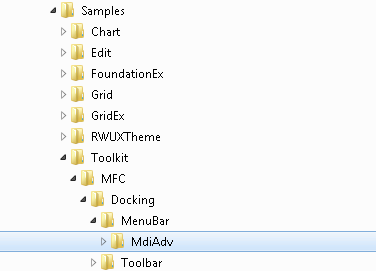Samples
The following diagram shows a portion of the
Samples directory organization.

Note that samples that are specific to a given subsystem are below the appropriate subsystem directory.
Location of Sample Code
Stingray Studio ships the most basic and commonly used samples with the product itself. The less commonly used and more specialized samples have been removed from the product distribution, but are available from the Rogue Wave Web site or by request from Technical Support.
If you are looking for a sample and it does not appear under <stingray-installdir>\Samples\<product-name>\<sample-name>, you can download the sample bundle from the Knowledge Base on the Rogue Wave web site at http://kb.roguewave.com/kb/index.php?View=entry&EntryID=1398.
The self-extracting archive, Stingray Studio Additional Samples.exe, contains a text file listing all samples in the archive. The archive includes older samples that are easy to update to work with the latest release of Stingray, but that do not ship with the release.
To update samples for later Stingray Studio releases:
• In the sample's stdafx.h file, add the following #include above all other include statements:
#include "SupportedPlatforms.h"
• Update macro names if necessary.
Some samples use old macro names which must be replaced with the current name. For example, you would replace
DECLARE_CONTROL with
GRID_DECLARE_CONTROL. For details, please see
“Extending Stingray Libraries.”• For Visual Studio 2010 or later, add property sheets.
If the sample you are looking for is not shipped with the product or in this archive, you can submit a request to Technical Support.


